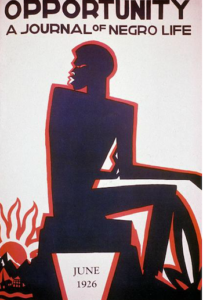
June 1926 issue
*The first issue of Opportunity: A Journal of Negro Life was published in January 1923. Opportunity was an academic journal published by the National Urban League (NUL).
The journal acted as a sociological forum for the emerging topic of African American studies and was known for fostering the literary culture during the Harlem Renaissance. It was published monthly from 1923 to 1942 and then quarterly through 1949. While the journal was published from 1923 to 1949, its primary influence on Black literature was from 1923 to 1928. Opportunity's immediate objective was to publish reliable data concerning black life and race relations.
Editor-in-chief Charles S. Johnson wrote in the first issue of Opportunity, "Accurate and dependable facts can correct inaccurate and slanderous assertions that have gone unchallenged… and what is most important, to inculcate a disposition to see enough of interest and beauty of their own lives to rid themselves of the inferior feeling of being Negro".
Central to Opportunity's founding were two patrons: Mrs. Ruth Standish Baldwin, the white widow of railroad magnate William Henry Baldwin Jr., and George Edmund Haynes. Haynes, a Fisk University graduate, Yale University, and Columbia University, became the NUL's first executive secretary. The interracial character of the League's board was set from its first days; it was the template for Charles Johnson's approach to fostering interest, support, and occasion for African American art and artists. Critics of the journal and the Harlem Renaissance thought Johnson's literary content may have been pandering to his white audience and patrons.
Wallace Thurman said, "The results of the Renaissance have been sad rather than satisfactory, in that critical standards have been ignored and the measure of achievement has been racial rather than literary.” Under Johnson's editorship, the journal's circulation rose to 11,000 in 1928. While not as widely read as The Crisis or The Messenger, the journal was instrumental in providing breaks for new artists through its literary contests and literary parties. As the first editor-in-chief of Opportunity, Johnson immediately broadened the journal from a purely sociological journal to a multi-faceted publication that included Black arts. He published photographic essays, artworks, and poetry, besides research studies.
Powerful photojournalism illustrated the quality of life for working Blacks across America. Johnson is credited for organizing and promoting literary parties, successfully bringing together Black artists and white patrons of money and letters. From 1924 to 1927, Johnson sponsored three literary contests. The May 1925 issue of Opportunity lists several prizewinners who enjoyed successful publishing careers: Claude McKay, Zora Neale Hurston, Langston Hughes, Countee Cullen, Sterling Brown, and Franklin Frazier. From 1925 to 1927, Johnson provided over three contest award dinners; on average, almost 350 Black artists, white patrons, and publishers attended.
According to Arna Bontemps, a contributor to Opportunity, these events provided enthusiasm for Black artists, increased white patronage, and provided exposure to the major New York City publishers (Knopf, MacMillan, and Harpers). After 1928, when Johnson accepted the presidency of Fisk University, chief editors of the journal included Elmer Anderson Carter (October 1928 - January 1945), Madeline L. Aldridge (January 1945 - June 1947), and Dutton Ferguson (July 1947 - January 1949). Under Carter's editorship, the journal resumed its focus on publishing sociological studies of African Americans and continued with this purpose until it ceased publication in 1949.